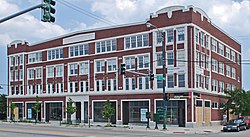United States historic place
| Overton Hygienic Building | |
| U.S. National Register of Historic Places | |
| U.S. Historic district Contributing property | |
| Chicago Landmark | |
 | |
   | |
| Location | 3619-27 S. State St. Chicago, Illinois |
|---|---|
| Coordinates | 41°49′40.94″N 87°37′34.26″W / 41.8280389°N 87.6261833°W / 41.8280389; -87.6261833 |
| Built | 1922 |
| Architect | Z. Erol Smith |
| MPS | Black Metropolis TR |
| NRHP reference No. | 86001091 |
| Significant dates | |
| Added to NRHP | April 30, 1986 |
| Designated CL | September 9, 1998 |
Hygienic Manufacturing Company, also known as Overton Hygienic Company, was a cosmetics company established by Anthony Overton. It was one of the nation's largest producers of African-American cosmetics. Anthony Overton also ran other businesses from the building, including the Victory Life Insurance Company and Douglass National Bank, the first nationally chartered, African-American-owned bank. The Overton Hygienic Building is a Chicago Landmark and part of the Black Metropolis-Bronzeville District in the Douglas community area of Chicago, Illinois. It is located at 3619-3627 South State Street.
The building was commissioned by Anthony Overton in 1922 as a combination of a store, office, and manufacturing building. It was regarded as one of the most important buildings within the district. Overton would later commission the Chicago Bee Building in 1929.
Walter T. Bailey, the first licensed African-American architect in the state of Illinois, had his first Chicago office on the second floor of the Overton Hygienic Building.
The building was later named the Palace Hotel and served for some time as a flophouse, with residents crowded into stalls 8 feet by 5½ feet. The second, third, and fourth floors each housed 125 stalls, with dormitory-style bathrooms and showers, for a total of 375 stalls. The building is now owned and being developed by the Mid-South Planning and Development Commission, which will use the building as an incubator for small businesses and startups within the Black Metropolis neighborhood.
References
- "National Register Information System". National Register of Historic Places. National Park Service. January 23, 2007.
- "Chicago Landmarks - Overton Hygienic Building". Chicago Landmarks Commission. 2003. Archived from the original on June 7, 2007. Retrieved June 26, 2007.
- "National Register of Historic Places Multiple Property Submission: Black Metropolis Thematic Nomination". November 7, 1985. Retrieved June 26, 2007.
- Bey, Lee. "Art Moderne beauty: First Church of Deliverance Archived 2012-09-15 at the Wayback Machine", WBEZ, 91.5, February 15, 2010, accessed November 29, 2010.
- Savage, Beth L. and National Register of Historic Places. African-American Historic Places, (Google Books link), John Wiley and Sons, 1994, p. 207, (ISBN 0471143456).
- Wilson, Dreck Spurlock. African-American Architects: A Biographical Dictionary (1865-1945), (Google Books link), Taylor & Francis, 2004, pp. 15-17, (ISBN 0415929598).
- "The View from the Ground - Blog Archive - Up on the Roof". June 30, 2001. Archived from the original on October 23, 2006. Retrieved June 26, 2007.
- "Chicago Travel Itinerary - Overton Hygienic Building". National Park Service. Retrieved June 26, 2007.
| U.S. National Register of Historic Places | |
|---|---|
| Topics | |
| Lists by state |
|
| Lists by insular areas | |
| Lists by associated state | |
| Other areas | |
| Related | |